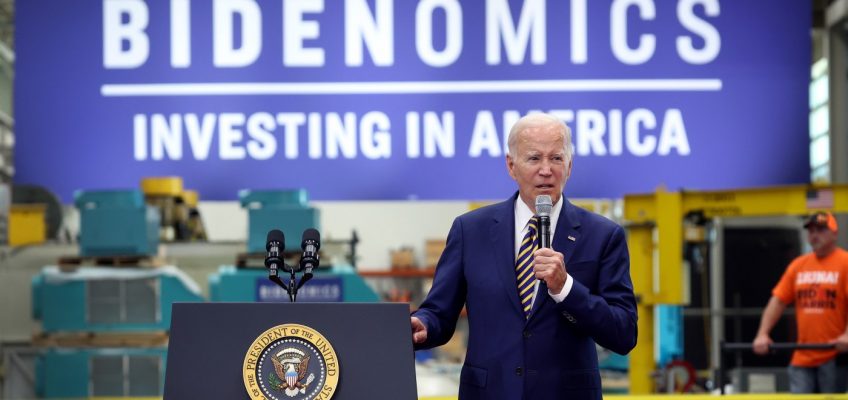President Joe Biden has been traveling the U.S. touting a manufacturing revival that he no doubt hopes will help his chances for re-election. Unfortunately, there is much less substance to this “Biden Boom” than the White House would have Americans believe. Even under the rosiest of projections, the administration’s signature programs will do little to increase manufacturing employment — and even less to uplift the overall economy.
Construction spending on manufacturing facilities more than doubled from an annualized rate of $81 billion this time last year to an all-time high of nearly $200 billion in August. Some of that increase can be attributed to the incentives provided by the Inflation Reduction Act and the CHIPS Act, both championed by the president.
But there are more relevant factors. Shortages caused by COVID, backlogs at major ports in 2021 and a three-year-long (and continuing) surge in retail sales created a compelling case for reshoring production even without those incentives. Spending on consumer goods is 30% higher now than when the pandemic started, and global supply chains have yet to fully recover. So a near-term expansion in domestic manufacturing was all but inevitable.
Another reason the recent run-up in manufacturing investment is not as impressive as it might seem: When adjusted for inflation, the figures are overshadowed by a decline in investment in the rest of the economy.
An analysis conducted by the Labor Energy Partnership, a strong supporter of Biden’s policies, said they would create 150,000 additional manufacturing jobs by 2030. That amounts to an increase of just 1.3% relative to the 13.1 million workers in employed in manufacturing right now. By comparison, the U.S. economy created 272,000 manufacturing jobs in 2018 alone.
The administration hopes that by funneling its resources toward semiconductors and green energy, it can foster the growth of a manufacturing ecosystem that will ensure U.S. leadership in high-tech manufacturing. Research suggests otherwise.
Analysts at the World Trade Organization summarize evidence this way: For fully developed economies, direct investment has no benefits for either domestic suppliers or purchasers of manufacturing products. That’s because investors are already aware of what they have to offer, and capital markets — in the U.S. especially — can easily finance the creation of new industries if there is a strong business case for them.
In fact, the Biden administration’s tendency to include incentives favorable to unions and other progressive interests in these programs and can actually make it more difficult for investors to ascertain the full costs of expanding production in the U.S.
The president is no doubt sincere in his desire to revive U.S. manufacturing, and it’s tempting to look at the surge in reshoring as evidence that his administration’s policies are having a transformative effect. Yet even the most optimistic projections suggest that Biden’s industrial policy will have only a minor effect on U.S. manufacturing employment.
Karl W. Smith is a Bloomberg Opinion columnist/Tribune News Service


Leave a Reply